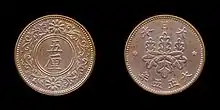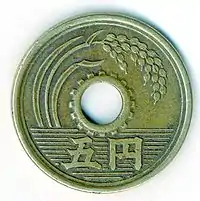5 rin coin
The five rin coin (五厘青銅貨) was a Japanese coin worth one two-hundredth of a Japanese yen, as 5 rin equalled 1⁄2 sen, and 100 sen equaled 1 yen.[1] These coins were a successor to the half sen coin which had been minted until 1888. The history of the five rin coin is brief as they were only minted from 1916 to 1919 before being devalued monetarily. Five rin coins were later demonetized by the end of 1953, and are now widely available for collectors.
Japan | |
| Value | 1⁄200 Japanese Yen |
|---|---|
| Mass | 2.1 g |
| Diameter | 18.78 mm |
| Edge | Smooth |
| Shape | circular |
| Composition | 95% Copper 5% Tin and Zinc |
| Years of minting | 1916–1919 |
| Obverse | |
| Reverse | |
History
Five rin coins are first mentioned in new coinage laws that were passed in 1897 when Japan went on the gold standard.[2] The quality of the coins were set in a bronze alloy consisting of 95% copper, and 5% tin and zinc.[2] The value of five rin coins was the same as it had been for the formerly issued half sen coin, which had been made from 1873 to 1888. Five rin coins are smaller than their predecessor at 18.78mm wide and weigh over a gram less.[3] Only patterns were struck towards the end of Emperor Meiji's reign as the urgent task at the time was to manufacture gold and silver coins in accordance with the new law.[4][5] Five rin coins were eventually minted for circulation in 1916 during the 5th year of Emperor Taishō's reign. This was in response to rising inflation caused by World War I which led to an overall shortage of subsidiary coins.[4] Production only lasted three more years before the coins were discontinued due to a sharp decline in monetary value.[3] The demand for subsidiary coinage had ended by this time as Japan slipped into a post-war recession.[4] All five rin coins were eventually taken out of circulation at the end of 1953 and demonetized. The Japanese government passed a new law during this time that abolished subsidiary coinage in favor of the yen.[6] Five rin coins are now easily obtainable in circulated grades. This is due to a large amount of surviving coins that were kept by the public either as souvenirs or from unused accumulation.[7]
Circulation figures
Taishō

The following are circulation figures for the five rin coin, all of which were minted between the 5th and 8th year of Taishō's reign. The dates all begin with the Japanese symbol 大正 (Taishō), followed by the year of his reign the coin was minted. Each coin is read clockwise from right to left, so in the example used below "五" would read as "year 5" or 1916.
- "Year" ← "Number representing year of reign" ← "Emperor's name" (Ex: 年 ← 五 ← 正大)
| Year of reign | Japanese date | Gregorian date | Mintage[8] |
|---|---|---|---|
| 5th | 五 | 1916 | 8,000,000[8] |
| 6th | 六 | 1917 | 5,287,584[8] |
| 7th | 七 | 1918 | 11,661,877[8] |
| 8th | 八 | 1919 | 17,130,539[8] |
References
- John Crowdy (1873). "The British Almanac". Stationers' Company. p. 112-113. Retrieved December 9, 2016.
- Law No. XVI of the 20th day of March of the 30th year of Meiji (1897). Report on the Adoption of the Gold Standard in Japan. 1899. p. 192-193.
- "5厘青銅貨" (in Japanese). www.buntetsu.net. Retrieved December 9, 2016.
- "五厘青銅貨 5 Rin (Bronze)". Pepper's Square (in Japanese). Retrieved November 14, 2020.
- "Japan: Meiji copper Pattern 5 Rin Year 32 (1899)". Heritage Auctions. Retrieved September 12, 2020.
- "小額通貨の整理及び支払金の端数計算に関する法律" [A law of the abolition of currencies in a small denomination and rounding off a fraction, July 15, 1953 Law No.60]. www.shugiin.go.jp. Archived from the original on June 28, 2002. Retrieved December 5, 2016.
- "【5厘硬貨・銅貨】買取価値はいくら?平均価格&査定相場《最新版》". Kosen Kantei (in Japanese). Retrieved September 12, 2020.
- Chester L. Krause & Clifford Mishler. Collecting World Coins 10th edition. Krause Publications. p. 429.

